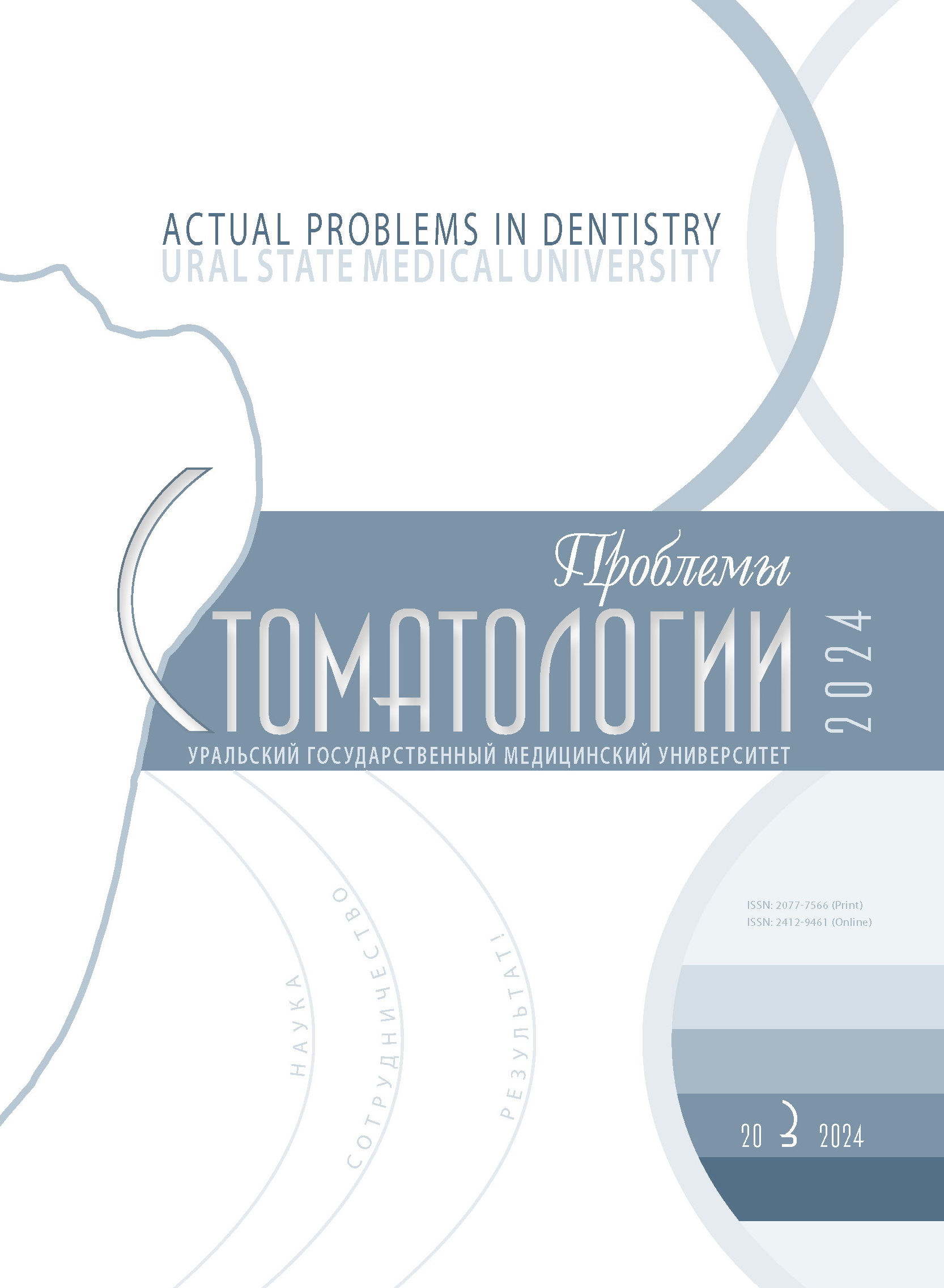Moscow, Moscow, Russian Federation
Moscow, Moscow, Russian Federation
Moscow, Moscow, Russian Federation
Moscow, Moscow, Russian Federation
UDC 616.31
An urgent problem in modern maxillofacial surgery remains the question of choosing the optimal osteoplastic material when eliminating diastasis of bone tissue, especially when replacing large defects. An active search and testing of new biocomposites that stimulate osteohistogenesis continues, assessing their effectiveness and safety. Aim of the study: characteristics of osteoregeneration after implantation of “BAK-1000” in combination with MSCs stimulated in the angiogenic direction in an experiment. Materials and methods. Experimental animals (Sprague Dawley rats, age 13–15 weeks, n = 30, ♂) in this study were randomly divided into two groups – control and experimental (15 animals in each). The first stage of the experiment is the cultivation of mesenchymal stem cells, the second is the creation and filling of bone defects using implantation material and autologous MSCs. Results. A histochemical study two months after implantation of the biocomposite in combination with MSCs revealed moderate development of signs of osteohistogenesis, pronounced neoangiogenesis and the formation of bright yellow crystals. Administration of BAC-1000 to animals in the control group demonstrated the formation of a connective tissue capsule around the implanted material with virtually no signs of osteohistogenesis and neoangiogenesis. Conclusions. In the experiment, the use of a biocomposite consisting of “BAK-1000” in combination with angiostimulated MSCs was tested. Based on a histochemical study, it was noted that it is ineffective in closing extensive bone tissue defects, however, additional cultivation of these cells on a matrix of osteoplastic materials can enhance the processes of osteohistogenesis and neoangiogenesis, inducing bone tissue metabolism and stimulating the formation of connective tissue in the diastasis zone, which may be the reason for further studies of such combinations.
osteohistogenesis, connective tissue, apatite silicate material, mesenchymal stem cells, histochemistry
1. Demyashkin G.A., Ivanov S.Yu., Nuruev G.K., Fidarov A.F., Chuev V.V., Chueva A.A., Vadyuhin M.A., Bondarenko F.N. Morfofunkcional'nye osobennosti osteoregeneracii cherez dva mesyaca posle implantacii "BAK-1000" v kombinacii s angiostimulirovannymi mezenhimal'nymi stvolovymi kletkami. Stomatologiya dlya vseh. 2022;4(101):34-38. [G.A. Demyashkin, S.Yu. Ivanov, G.K. Nuruev, A.F. Fidarov, V.V. Chuev, A.A. Chueva, M.A. Vadyukhin, F.N. Bondarenko. Morphofunctional features of osteoregeneration two months after implantation of “BAK-1000” in combination with angiostimulated mesenchymal stem cells. Dentistry for everyone. 2022;4(101):34-38. (In Russ.)]. https://doi.org/10.35556/idr-2022-4(101)34-38
2. Dreyer C.H., Jørgensen N.R., Overgaard S., Qin L., Ding M. Vascular Endothelial Growth Factor and Mesenchymal Stem Cells Revealed Similar Bone Formation to Allograft in a Sheep Model // Biomed Res Int. – 2021;2021:6676609. https://doi.org/10.1155/2021/6676609
3. Frigério P.B., Quirino L.C., Gabrielli M.A.C., Carvalho P.H.A., Garcia Júnior I.R., Pereira-Filho V.A. Evaluation of Bone Repair Using a New Biphasic Synthetic Bioceramic (Plenum® Osshp) in Critical Calvaria Defect in Rats // Biology (Basel). – 2023;12(11):1417. https://doi.org/10.3390/biology12111417
4. Meesuk L., Suwanprateeb J., Thammarakcharoen F. Osteogenic differentiation and proliferation potentials of human bone marrow and umbilical cord-derived mesenchymal stem cells on the 3D-printed hydroxyapatite scaffolds // Sci Rep. – 2022;12(1):19509. https://doi.org/10.1038/s41598-022-24160-2
5. Nisar A., Iqbal S., Atiq Ur Rehman M., Mahmood A., Younas M., Hussain S.Z., Tayyaba Q., Shah A. Study of physico-mechanical and electrical properties of cerium doped hydroxyapatite for biomedical applications // Mater. Chem. Phys. – 2023;299:127511. https://doi.org/10.1016/j.matchemphys.2023.127511
6. Papachristou D.J., Georgopoulos S., Giannoudis P.V., Panagiotopoulos E. Insights into the Cellular and Molecular Mechanisms That Govern the Fracture-Healing Process: A Narrative Review // J Clin Med. – 2021;10(16):3554. https://doi.org/10.3390/jcm10163554
7. Papynov E.K., Shichalin O.O., Belov A.A., Buravlev I.Y., Mayorov V.Y., Fedorets A.N., Buravleva A.A., Lembikov A.O., Gritsuk D.V., Kapustina O.V. CaSiO3-HAp Metal-Reinforced Biocomposite Ceramics for Bone Tissue Engineering // J. Funct. Biomater. – 2023;14:259. https://doi.org/10.3390/jfb14050259
8. Robert A.W., Marcon B.H., Dallagiovanna B., Shigunov P. Adipogenesis, Osteogenesis, and Chondrogenesis of Human Mesenchymal Stem/Stromal Cells: A Comparative Transcriptome Approach // Front Cell Dev Biol. – 2020;8:561. https://doi.org/10.3389/fcell.2020.00561
9. Rodríguez-Merchán E.C. A Review of Recent Developments in the Molecular Mechanisms of Bone Healing // International journal of molecular sciences. – 2021;22(2):767. https://doi.org/10.3390/ijms22020767
10. Safarova Yantsen Y., Olzhayev F., Umbayev B. Mesenchymal Stem Cells Coated with Synthetic Bone-Targeting Polymers Enhance Osteoporotic Bone Fracture Regeneration // Bioengineering (Basel). – 2020;7(4):125. https://doi.org/10.3390/bioengineering7040125
11. Vasilyev A.V., Kuznetsova V.S., Bukharova T.B. Development prospects of curable osteoplastic materials in dentistry and maxillofacial surgery // Heliyon. – 2020;6(8):e04686. https://doi.org/10.1016/j.heliyon.2020.e04686
12. Wei S., Ma J.X., Xu L., Gu X.S., Ma X.L. Biodegradable materials for bone defect repair // Military Medical Research. – 2020;7(1):54. https://doi.org/10.1186/s40779-020-00280-6



















